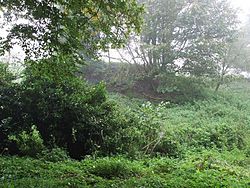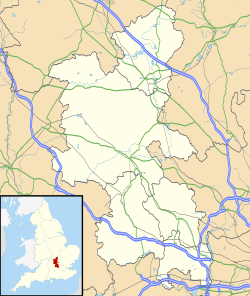Bolbec Castle facts for kids
Quick facts for kids Bolbec Castle |
|
|---|---|
| Buckinghamshire, England | |

Bolebec Castle motte
|
|
| Coordinates | 51°52′49″N 0°50′22″W / 51.880356°N 0.839559°W |
| Type | Castle |
| Site information | |
| Condition | Demolished |
| Site history | |
| Materials | Masonry |
Bolbec Castle or Bolebec Castle was an old castle located in the village of Whitchurch, Buckinghamshire, England. It was once a strong fortress, but today only its earthworks remain.
Contents
A Castle's Story
Bolbec Castle was a special type of castle called a motte and bailey castle. This means it had a large earth mound (the motte) with a tower on top. Next to it was a walled area (the bailey) where people lived and worked.
Building During a Difficult Time
The castle was built around 1147 for a person named Hugh II de Bolbec. This was during a period in English history known as the Anarchy. The Anarchy was a time of great conflict and civil war. It was a struggle for the throne between King Stephen and Empress Matilda.
Because of this conflict, many castles were built without official permission. Bolbec Castle was one of them. Even Pope Eugene III, a very important religious leader, spoke out against its construction.
What the Castle Looked Like
Experts believe Bolbec Castle had a strong stone tower, called a keep, on top of its motte. The deep ditches and banks around the motte made it even harder for enemies to attack. The castle's bailey was shaped like a triangle. Today, a road called Castle Lane separates the motte from the bailey.
Its End in the Civil War
Centuries later, during the English Civil War (1642–1651), the castle met its end. This war was fought between those who supported King Charles I and those who supported Parliament. A famous leader named Oliver Cromwell, who led the Parliament's army, was responsible for destroying many castles, including Bolbec Castle. This was done to prevent them from being used as strongholds by the enemy.
What Remains Today
Even though the castle itself is gone, you can still see its earthworks. These are the mounds and ditches left behind from the original structure. These surviving earthworks are very important. They are protected as a scheduled monument, which means they are a nationally important historical site.


